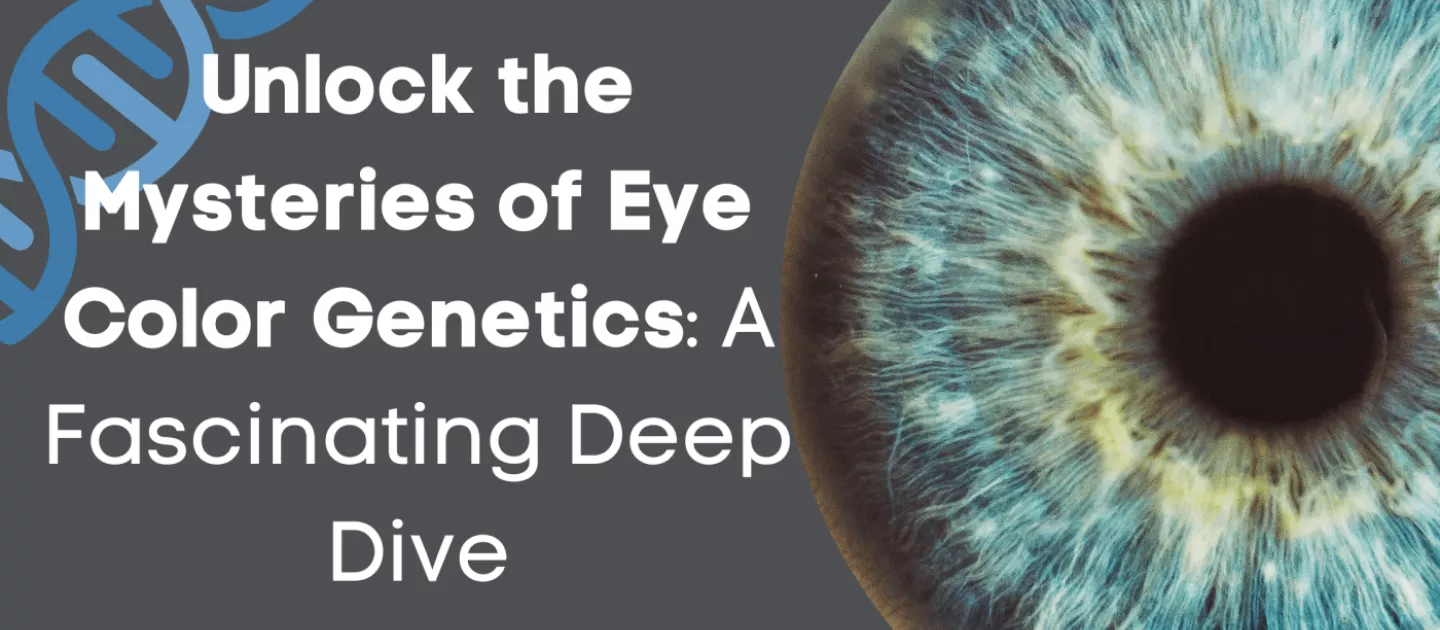Eye color genetics is a complex and fascinating field of study. In order to understand how eye color is inherited, we need to first understand the concept of dominant and recessive genes. Genes are the basic units of heredity that determine our traits, such as eye color. Each gene comes in two forms, or alleles, one inherited from each parent. If both alleles are the same, the gene is said to be homozygous. If the alleles are different, the gene is said to be heterozygous.
When it comes to eye color genetics, there are several genes involved, each with its own unique role in determining the color of our eyes. The most important gene involved in eye color determination is called OCA2. This gene produces a protein that helps to control the amount of melanin, the pigment that gives color to our skin, hair, and eyes, in the iris. The amount of melanin in the iris determines the color of our eyes, with more melanin resulting in darker colors like brown and black and less melanin resulting in lighter colors like blue and green.
The OCA2 gene is not the only gene involved in eye color determination, however. Other genes, such as HERC2 and TYR, also play a role. In fact, there are over a dozen genes that have been identified as contributing to eye color variation. Some of these genes are dominant, meaning that only one copy of the allele is needed to produce a certain eye color. Other genes are recessive, meaning that two copies of the allele are needed to produce a certain eye color.
The Role of Melanin in Eye Color
Melanin is a pigment that is produced by specialized cells called melanocytes. This pigment is responsible for the color of our skin, hair, and eyes. In the case of eye color, melanin is produced by melanocytes in the iris, the colored part of the eye. The amount and type of melanin in the iris determine the color of our eyes.
There are two types of melanin that are involved in eye color determination: eumelanin and pheomelanin. Eumelanin is a dark brown pigment that is responsible for brown and black eye colors. Pheomelanin, on the other hand, is a red-yellow pigment that is responsible for lighter eye colors like blue and green.
The amount of melanin in the iris is determined by several genes, including the OCA2 gene mentioned earlier. Other genes, such as TYR and SLC24A4, also play a role in melanin production. Interestingly, the same genes that determine melanin production in the skin and hair also play a role in eye color determination.
Common Eye Colors and Their Genetic Makeup
Eye color is a highly variable trait, with many different colors and shades found across different populations. However, there are a few common eye colors that are seen in the majority of people. These include brown, green, blue, and gray.
Green eyes are less common than brown eyes, with only about 2% of the world's population having green eyes. Green eyes are caused by a combination of eumelanin and a small amount of pheomelanin in the iris. The gene for green eyes is recessive, meaning that two copies of the allele are needed to produce green eyes.
Blue eyes are also relatively uncommon, with only about 8% of the world's population having blue eyes. Blue eyes are caused by a lack of melanin in the iris, which allows light to scatter and reflect back, giving the eyes their blue color. The gene for blue eyes is also recessive, meaning that two copies of the allele are needed to produce blue eyes.
Gray eyes are a rare eye color that is seen in some people. Gray eyes are caused by a combination of a small amount of melanin and a large amount of collagen in the iris. The gene for gray eyes is thought to be a variation of the gene for blue eyes.
Can Eye Color Change Over Time?
Many people wonder whether their eye color can change over time. The answer is yes, although it is rare. Eye color is determined by the amount and type of melanin in the iris, which is largely determined by genetics. However, there are some factors that can cause changes in eye color.
One of the most common causes of changes in eye color is aging. As we age, the amount of melanin in our irises can change, causing our eye color to become lighter or darker. Hormonal changes during pregnancy or puberty can also cause changes in eye color.
Certain diseases, such as Horner's syndrome and Fuch's heterochromic iridocyclitis, can also cause changes in eye color. These conditions affect the production and distribution of melanin in the iris, leading to changes in eye color.
Eye Color Inheritance Patterns in Families
Eye color is an inherited trait, meaning that it is passed down from our parents. However, the inheritance pattern of eye color is not as simple as a single gene with dominant and recessive alleles. Instead, eye color is determined by multiple genes, each with their own unique role in determining the color of our eyes.
The inheritance pattern of eye color can vary depending on the genes involved. In general, brown eyes are dominant over green and blue eyes, meaning that if one parent has brown eyes and the other has green or blue eyes, their children are more likely to have brown eyes. However, there are many exceptions to this rule, and eye color can be highly variable even within families.
Genetic Testing for Eye Color Prediction
With advances in genetic testing technology, it is now possible to predict a person's eye color based on their DNA. This type of testing is known as forensic DNA phenotyping and is used by law enforcement agencies to help identify suspects based on physical traits like eye color.
Forensic DNA phenotyping works by analyzing specific genes that are known to be involved in eye color determination. By looking at variations in these genes, scientists can predict the likelihood of a person having certain eye colors. However, it is important to note that these predictions are not always accurate and can be influenced by environmental factors like aging and hormonal changes.
Environmental Factors That May Influence Eye Color
While genetics is the primary factor in determining our eye color, there are also environmental factors that can influence the color of our eyes. One of the most well-known factors is exposure to sunlight. Sunlight can cause the melanin in our irises to darken, leading to changes in eye color over time.
Other factors that may influence eye color include diet and nutrition, stress, and illness. For example, a lack of certain nutrients like vitamin A can lead to changes in eye color, while stress and illness can cause changes in the distribution of melanin in the iris.
Eye Color Diversity Across Different Populations
Eye color is a highly variable trait that varies widely across different populations. For example, brown eyes are most common in people of African and Asian descent, while blue and green eyes are more common in people of European descent. This variation is thought to be the result of a combination of genetic and environmental factors.
The Complexity of Eye Color Genetics
In conclusion, eye color genetics is a complex and fascinating field of study that has much to teach us about inherited traits and human diversity. While the color of our eyes is largely determined by genetics, there are also environmental factors that can influence eye color over time. Understanding the science behind eye color genetics can help us better understand our ancestry and family history, as well as the complex interplay between genetics and the environment. So, the next time you look into someone's eyes, take a moment to appreciate the complexity and diversity of the genetic factors that make them unique.
Sources:
Is eye color determined by genetics?: MedlinePlus Genetics
Eye Colors: Rarest Eye Color, Baby Eye Color, Heterochromia (clevelandclinic.org)











